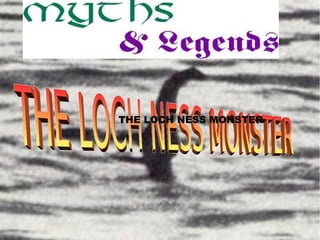
The monster of loch ness
- 1. THE LOCH NESS MONSTER
- 2. Index 1: Home Page 2: Index 3: Description 4: Hypotheses about their origin 5, 6, 7, 8, 9, 10, 11: Urban legend 12: Bibliography
- 3. DESCRIPTION The Loch Ness Monster is a cryptid that is reputed to inhabit Loch Ness in the Scottish Highlands. It is similar to other supposed lake monsters in Scotland and elsewhere, though its description varies from one account to the next. Popular interest and belief in the animal has varied since it was brought to the world's attention in 1933. Evidence of its existence is anecdotal, with minimal and much-disputed photographic material and sonar readings.
- 5. Hypotheses about their origin Plesiosaur: Most modern descriptions of the appearance of the monster, indicate that there would be a creature that would resemble the extinct plesiosaur, a prehistoric aquatic creatures. So, the modern description that is given normally would be similar to that presented plesiosaurs fossils members of the Mesozoic era, which indicate that this prehistoric animal had to be an animal physically enormous with a long neck, small head and two pairs propulsion fin underwater.
- 6. Urban Legend For centuries, myths have circulated about the monster that is said to live in the depths of Loch Ness in Scotland. Nessi observations, as affectionately called, date back to 1,500 years ago. Recently, some observers have returned with "evidence" Photographic, although much of it has proven to be false. One explanation is that Nessie is a dinosaur, that somehow escaped extinction. If this is true, the monster could escape detection, even with
- 8. The first modern description happened in 1868. An article published this year in the Inverness Courier, is the first to refer about rumors about the existence of a "big fish or other creature" in the depth of the water. Then, in 1930, the newspaper The Northern Chronicle, published a report titled "A strange experience at Loch Ness" which details the story of two fishermen that refer to an animal that produced a large swirl near Tore Point. In 1932, K. MacDonald said he had saw a crocodile-like creature up the river Ness.
- 10. On May 2, 1933 Inverness Courier newspaper published the news of a local couple who said he saw "an enormous animal rolling and plunging on the surface". The report of the "monster" became a media sensation. London publishers began sending reporters to Scotland, and even a circus offered a £ 20,000 reward for the capture of the monster. The same year, A.H. Palmer, who witnessed one sighting of Nessie on August 11, 1933 at the creature as having its head surface of the water. His mouth, having a width of 30-45 cm, opened and closed, the maximum aperture of his mouth was estimated at about 15 cm. Until this moment simply newspapers spoke of a mysterious or strange fish creature, did not refer to the creature as being prehistoric.
- 12. On April 19, 1934 was published the photograph (above the black and white) taken by surgeon RK Wilson happy animal, showing a huge long-necked creature that slid through the water. Decades later, on March 12, 1994, Marmaduke Wetherell claimed to have faked the photo after being employed by the Daily Mail to find Nessie, also indicating that Wilson would not have taken the photo, and that his name was only used to give more credibility to it. This photo has been spread throughout the world and is now an urban legend.
- 13. Bibliography Picture: Google images: The Loch Ness Monster Information: http://es.wikipedia.org/wiki/Monstruo_del_lago_Ness http://www.planetacurioso.com/2007/05/10/el-monstruo del-lago-ness-leyenda-urbana/
